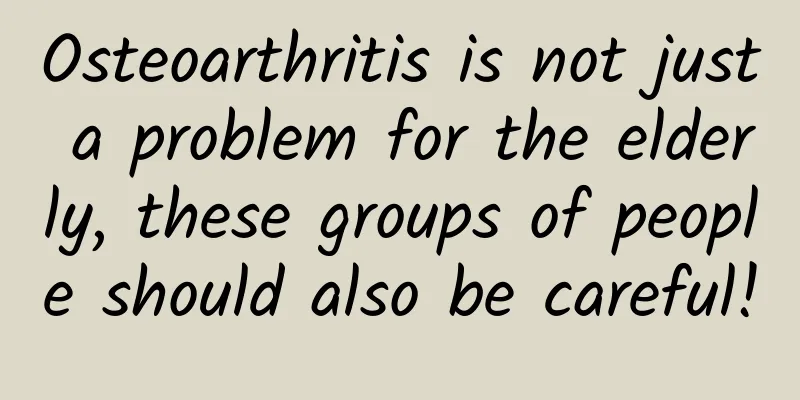Osteoarthritis is not just a problem for the elderly, these groups of people should also be careful!

|
Osteoarthritis: a growing global disease burden Osteoarthritis is an important cause of chronic pain and motor impairment in adults. Since 1990, the global burden of osteoarthritis has gradually increased, and the incidence and prevalence have both shown an upward trend. According to the Global Burden of Disease (GBD), the number of people with osteoarthritis worldwide has increased from 20.342 million in 1990 to 41.468 million in 2019; the age-standardized incidence rate has increased from 473.6/100,000 in 1990 to 492.2/100,000 in 2019. The situation in China is not optimistic either. The incidence and prevalence of osteoarthritis are higher than the Asian average. As the aging population intensifies, it is estimated that by 2044, the number of people suffering from osteoarthritis in China will increase by 1.5 times compared to 2019 . Age-standardized incidence, standardized prevalence, and standardized DALYs rates of osteoarthritis in regions with a high global disease burden, 1990-2019 But what is more worrying is that osteoarthritis is no longer an "old age disease". In recent years, more and more young people, especially those engaged in physical labor, have also begun to show symptoms of osteoarthritis. The number of patients with "early-onset osteoarthritis" under the age of 55 is increasing rapidly. Globally, the number of patients with this disease and the number of patients have doubled in the past 30 years . Epidemiological trends of the disease burden of osteoarthritis disability-adjusted life years in China from 1990 to 2021 People at high risk of osteoarthritis: Are you affected? Middle-aged and elderly people: The prevalence of osteoarthritis in people over 40 years old is as high as 46.3%, especially in the elderly over 60 years old, where the prevalence exceeds 60%. As we age, wear and tear of joints are inevitable. Postmenopausal women: Women, especially postmenopausal women, have a significantly higher risk of osteoarthritis than men. This is because estrogen has a protective effect on joint cartilage, and after menopause, estrogen levels drop, which accelerates joint degeneration. Obese people: Excess weight will increase the burden on joints, especially the knee joints. Studies have shown that high BMI (body mass index) is closely related to the occurrence and progression of osteoarthritis. In 2019, the global burden of osteoarthritis-related diseases caused by obesity was as high as 31.9/100,000. Rural and mountainous residents: People who engage in heavy physical labor for a long time, especially those living in rural and mountainous areas, have a higher risk of osteoarthritis. The southwestern mountainous areas are the areas with the heaviest burden of knee osteoarthritis in my country, which is closely related to the local terrain and labor methods. The dangers of osteoarthritis: more than just joint pain Osteoarthritis is more than just joint pain and impaired mobility. It can also lead to a range of other conditions: 1 Sarcopenia and fractures People with osteoarthritis are prone to muscle loss, especially in the lower limb muscles, which increases the risk of falls and fractures. 2 Cardiovascular disease Nearly 40% of osteoarthritis patients also suffer from cardiovascular diseases, such as heart failure, ischemic cardiomyopathy, etc. The inflammatory response caused by osteoarthritis may damage the vascular endothelium and increase the risk of cardiovascular disease. 3. Diabetes The risk of diabetes in patients with osteoarthritis is 1.16 to 1.25 times higher than that of normal people. Inflammatory mediators and insulin resistance are the main causes, while obesity and lack of exercise also increase this risk. 4 Impairment of psychological and cognitive functions More than 30% of osteoarthritis patients are depressed, especially those with hip osteoarthritis. Chronic pain and limited mobility may lead to cerebral cortical remodeling and increase the risk of dementia. Scientific Management: How to deal with osteoarthritis? Early prevention For high-risk groups, such as postmenopausal women and obese people, they should adjust their lifestyle as early as possible, control their weight and avoid excessive exercise. Rehabilitation Exercise For patients who have already suffered from osteoarthritis, rehabilitation exercise training is an important treatment method. Reasonable exercise can relieve pain, improve joint function, and reduce the risk of other chronic diseases. Multidisciplinary Management More and more studies have shown that osteoarthritis is closely related to multidisciplinary diseases, and multidisciplinary management of osteoarthritis patients has become an inevitable trend. Osteoarthritis patients should regularly monitor cardiopulmonary function, blood pressure, blood sugar and other indicators, and timely screen and intervene in related diseases. Mental health should not be ignored, especially the risk of depression and Alzheimer's disease. Specialist and multidisciplinary management of osteoarthritis Osteoarthritis is no longer limited to the elderly. Young people , obese people , and postmenopausal women all need to be vigilant. Early prevention, scientific treatment, and multidisciplinary management are the keys to dealing with osteoarthritis. Let us pay attention to joint health and stay away from the troubles of osteoarthritis! If you or someone around you has similar symptoms, do not ignore it. Go to the hospital for examination as soon as possible for early detection and early treatment! ▌The popular science theme of this article comes from the article "Journal of Peking Union Medical College": Disease burden and harm of osteoarthritis Original author: Wu Haotian, Lin Jianhao Editor: Liu Yang and Zhao Na Proofread by Li Na and Li Yule Producer: Peng Bin [Copyright Statement] "Pumch Medical Journal" advocates respect and protection of intellectual property rights. Reprinting and quoting are welcome, but authorization from this platform is required. If you have any questions about the content and copyright of the article, please send an email to [email protected], and we will communicate with you in a timely manner. Some of the pictures in this article are produced with the assistance of AI. The content is only for communication and learning, not for profit; popular science content is only used to popularize public health knowledge. Readers should not use it as a basis for individual diagnosis and treatment, and do not dispose of it on their own to avoid delaying treatment. For medical treatment, please visit the Peking Union Medical College Hospital APP online or offline. |
<<: Beware of the "odor bomb" on the table! Use chemical knowledge to "decode" dishes
>>: How will superconducting materials change our world?
Recommend
7 Popular Educational Short Videos
The increase in short video followers mainly come...
How does Zhihu build its brand?
How does a brand , starting from its brand name a...
Multiple world records? The ship lock is a hydraulic structure that is not ordinary
recently The Three Gorges North Line Ship Lock st...
Android March security update will fully fix MediaTek-SU permission vulnerability
Google today reiterated the importance of keeping...
Programmer skills get: some thoughts and understanding on code naming
[[120348]] A software will be implemented in code...
Nearly 20% of users have upgraded to iOS 15, and the speed has dropped significantly compared to 14
[[427118]] It has been 10 days since iOS 15 was r...
Inventory of Kuaishou advertising resources
1. Dual feed stream resource entry Note: The norm...
How can tool-type products achieve long-term user growth and retention?
How can tool products break through the dilemma o...
How much does it cost to make the Xiangtan coupon mini program? What is the quotation for developing Xiangtan coupon mini program?
How much does it cost to recruit investors for th...
Tianwen-2 goes to an asteroid for sampling: These space missions in 2025 are worth looking forward to!
In 2024, the global aerospace industry is full of...
Foshan WeChat mini program distribution function, how much does it cost to develop a mini program distribution system?
Distributing mini programs is the future developm...
Love Secrets: Handsome Man "Copyable Chatting Techniques" Baidu Cloud Download
Love Secrets: Stylish Man's "Copyable Ch...
Can blood type predict cancer? What you never expected is...
Expert of this article: Song Yingwei, Chief Techn...
LeTV Sports released 7 new products at once. How to play sports live broadcast?
Nowadays, any news related to LeTV will be made i...









